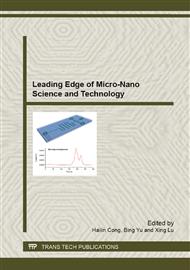p.331
p.335
p.340
p.349
p.355
p.360
p.366
p.371
p.377
Recovery Gemanium from Pulverized Fuel Ash through the Method of H2SO4-NH4F-NaClO3 - Leaching-Tannin Precipitation
Abstract:
This paper will conduct a systematic study on method of recovering Ge from pulverized fuel ash in Lincang prefecture, Yunnan province. Details are like this, in view of the fact that Ge contained in pulverized fuel ash is wrapped up by a lot of Silica, Cao, magnesium oxide and is difficult to react with hydrochloric acid, so, first, have the pulverized fuel ash grinded to 200 meshes; then, ammonium fluoride should be put into 85-90°Cdilute sulphuric acid solution to produce hydrogen fluoride so as to destroy silicon dioxide and calcium oxide contained in the pulverized fuel ash. Meanwhile, dilute sulphuric acid solution dissolves magnesium oxide, by doing so, Ge will be released to react with sulfuric acid and produce Sulfuric acid Ge, and Ge will go into the solution;as for low state Ge(e.g,GeO,GeS)contained in the pulverized fuel ash which is difficult to be dissolved by sulfuric acid, sodium chlorate will be used as a kind of oxidant to change bivalence Ge into tetravalence Ge, then dissolve it into the solution, after the liquid-solid separation, sulfuric acid leaching solution rich in Ge will be obtained. Then, tannic acid will be used as precipitant to recover Ge from the leaching solution, and Ge concentrate will be produced through distillation and roasting. After this, put Ge concentrate on hydrochloric acid distillation to get germanium tetrachloride, After going through strenuous evaporation, distillation and hydrolysis, germanium dioxide with high purity will be yield. This paper has conducted conditional tests and discussion on the process parameters which will influence recovery Ge from pulverized fuel ash, including the dosage of Sulfuric acid, ammonium fluoride, sodium chlorate ,tannic acid and extraction time to find out the prior controlling condition of Ge recovery,under this prior condition, Ge leaching rate is as high as 84%,and tannic sinking Ge rate is as high as 98%. The pulverized fuel ash, after recovering Ge, can be used to backfill the mine pit, besides, most of the lixivium after recovering Ge can be recycled, and the rest of it will be released after neutralized up to the standard by lime. This process enjoys the following quality: high Ge recovery rate, less time used during the process ,less consumption of auxiliary material, easier to control the process, avoiding the potential pollution on the environment and lower cost involved in it, therefore, which is a kind of efficient and economic process of recovering Ge from pulverized fuel ash.
Info:
Periodical:
Pages:
377-383
Citation:
Online since:
March 2013
Authors:
Price:
Сopyright:
© 2013 Trans Tech Publications Ltd. All Rights Reserved
Share:
Citation:


